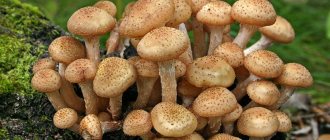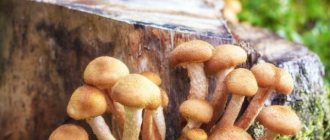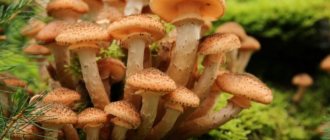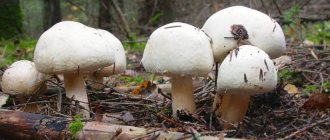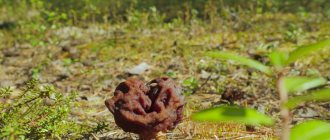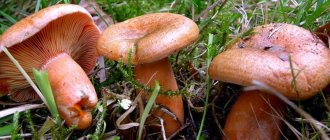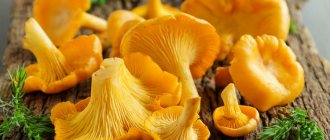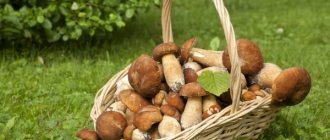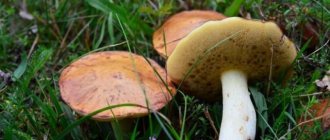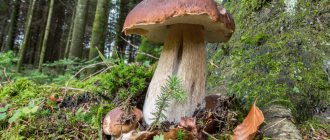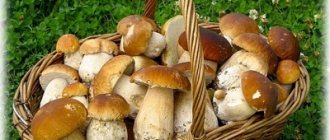The autumn forest fascinates everyone not only with its colors and nature, but also with the opportunity to collect delicious mushrooms for harvesting or freezing.
In the fall, many mushroom pickers go for honey mushrooms, but here you need to know in what period it is best to collect them and in which forests these mushrooms grow well. Under suitable conditions, you can collect a whole body of honey mushrooms.
When to collect autumn honey mushrooms: in what month
Forest honey mushrooms begin to open their season back in May: during this period you can find a variety of spring honey mushrooms in the forests.
But among mushroom pickers, autumn honey mushrooms are more popular, which, after collection, are happily eaten both fried or boiled, and pickled and salted.
Some even dry and freeze these mushrooms to preserve them for the winter.
Autumn honey mushrooms begin to grow around August (towards the end of the month) and continue until November. But, mostly, mushroom pickers go to the forest for honey mushrooms in September and October. The exact collection time may vary depending on the climate of the region.
It is at the beginning of autumn that honey mushrooms begin to be sold on the market, since during this period it actively bears fruit. If the weather is wet, then there will be a lot of harvest, since real autumn honey fungus begins to grow best in wet weather.
It is important that the autumn is not too cold: in this case, these mushrooms can be collected both for food and for sale.
For example, from one hectare it is quite possible to collect about half a ton of these mushrooms, if there are suitable places in the forest for honey mushrooms to grow.
But you need to know that only young mushrooms can be collected for food, since over time they will become rough and lose their taste. After this, you should not eat them, as they become almost wooden and tasteless.
Some mushroom pickers are confident that collecting autumn mushrooms can begin as early as July, but, as a rule, the mushrooms that appear during this period belong to a different type of mushroom.
In most regions with a temperate climate, honey fungus continues to bear fruit until October-November, and if the weather remains warm and there is no snow, then you can look for these mushrooms until December. But this is typical for regions with warm climates.
So, the harvest period of autumn mushrooms begins from the beginning of August and can last until October-November, it all depends on how warm the weather conditions are in the region.
Experienced mushroom pickers advise starting to collect this variety of mushrooms in early September. It is advisable to choose a time when the temperature is still above ten degrees Celsius.
Mushrooms - quiet hunting at Russian tourist centers
Just a few decades ago, mushrooms grew right under our feet.
They could be collected after rain, in any quantity, and not only in autumn. But civilization suppresses the natural environment. There are fewer and fewer forests and also fewer mushroom spots. Therefore, mushroom picking on turbahas has recently become increasingly popular. They provide a wide range of services in the field of mushroom picking and are usually located in picturesque, ecologically clean areas.
In these natural areas you can have a great time, go fishing, hunt and, of course, stock up on mushrooms.
Mushroom places in Russia
Central District
Recreation center "Pristan" . Located in the ecologically clean Yuzhsky district of the Ivanovo region. Here you can forget about all the hardships of the modern world, spend a weekend or vacation in a quiet, calm, serene environment.
In the second half of August, mushroom hunting begins here and lasts until the onset of frost. Boletus mushrooms, boletuses, and honey mushrooms just beg to be added to the frying pan. Also in this place you can ride horses, fish, and hunt.
Visitors are provided with cozy wooden houses for accommodation. They have everything you need - furniture, stove, refrigerator. They serve delicious homemade food. There is a sauna, a smokehouse, and a barbecue. The Klyazma River flows nearby, and around the base there are vast forests with rich flora and fauna.
North-West Russia
Tourist base "Lesnaya" . This recreation center is located in the Murmansk region near the Verkhnetulomskoye reservoir. Suitable for both family holidays and large groups. Visitors can choose from hotel rooms or private houses.
There is a cafe, sauna, conference room, and swimming pool. You can rent an ATV, a boat, or play billiards. In the autumn season, the most delicious gifts of the forest are collected. Here you can find boletuses, porcini mushrooms, boletus mushrooms, boletus mushrooms, milk mushrooms and trumpet mushrooms. With some luck, you can prepare even a bag of them.
The Lukomorye Country Recreation Center is always ready to receive guests throughout the year. Location: Pskov region, Pechora district, Molochkovo village. Residential cottages are located in the very center of a pine forest on the shores of Lake Pskov.
A secluded place away from the city delights with beautiful landscapes, clean pine air, and luxurious nature. There are houses with all amenities for tourists. There is a restaurant, a cinema hall, and a sports ground.
Lovers of quiet hunting come here at the end of summer and throughout the autumn period. Porcini mushrooms, boletus mushrooms, and butter mushrooms are being collected.
Here you can have a wonderful time with the whole family. There are water slides for children, walking, cycling, and educational excursions.
Volga region
Recreation center "Sunny Cape". It was built in the Shigonsky district (Samara region). It is located on the territory of the Murano Forest conservation area. Vacationers will be accommodated in summer houses, a hotel or log cottages.
There is a sandy beach on the banks of the Usa River, a children's playground, a disco, and a tennis court. You can go cycling and rowing boats.
The forest is home to 250 species of plants, many boletus, saffron milk mushrooms, milk mushrooms, Polish mushrooms, as well as boletus and boletus. Mushroom pickers come here in summer and autumn a couple of days after good rains.
Preparation and safety rules
Don't forget that not all mushrooms are edible. When cutting a mushroom, inspect it carefully. If you don’t know what kind of species it is, it’s better not to take it. You can see what a particular mushroom looks like on the Internet or in an encyclopedia.
Learn the distinguishing characteristics of poisonous look-alikes. The satanic mushroom is similar in appearance to the white one, the gall mushroom is similar to the boletus mushroom, and the pepper mushroom is similar to the oak mushroom. Pale toadstools are similar to russula. There are also false chanterelles and false honey mushrooms.
Due to the fact that mushroom picking is usually carried out in early autumn, and the mushroom trophies themselves often have to be looked for by raking fallen leaves, there is a danger of stumbling upon a poisonous snake that has not yet hibernated! To avoid troubles from such a meeting, use a stick 1-1.2 meters long to rake leaves and dead wood.
Also, take with you a folding knife, comfortable shoes, a compass, a cap, and a basket. To protect your body from ticks and scratches, choose clothes with long sleeves and elastic. The collar should fit snugly to the neck.
Most tourist centers, on the eve of the mushroom season, offer their clients the services of a specialist who will give you preparatory instructions, show you mushroom places, and also check your “catch” for edibility.
Happy hunting!
Source: https://mirturbaz.ru/blog/na-prirode/griby-tihaya-ohota-na-turbazah-rossii
Where do honey mushrooms grow and in what forests?
In general, these are parasitic mushrooms and they grow well in forests where there are many already dead trees. Wood that begins to weaken and rot is the best home for the growth of this type of mushroom. As practice shows, most honey mushrooms can be collected from oaks and birches.
These mushrooms are known to bear fruit very actively and grow en masse. Therefore, in some part of the forest they may not be, but if there are places in the forest with dying trees, then there will definitely be honey mushrooms there.
Literally from one place where these mushrooms accumulate, you can collect a decent basket of harvest in a short period of time.
It is this feature that attracts mushroom pickers - collecting honey mushrooms does not take much time and, with the right time and place, you can collect one or even two baskets in a few minutes.
An edible parasitic fungus can choose any host from wood, be it a bush, a full-fledged tree, a stump, or even broken branches. Sometimes the mushroom even grows on fallen leaves or potatoes.
In general, this variety of autumn mushroom can grow quietly on both dead and living wood. It bears the most fruit on rotten and weakened trees. Prefers oak and birch. Many honey mushrooms can be found in forests dominated by old or swampy birch.
The mushroom usually grows in such conditions at a height of four meters. Trunks, stumps and clearings are also an excellent place for honey mushrooms to bear fruit. The only thing that is not entirely suitable for these mushrooms is coniferous trees; there is almost no this variety of honey mushrooms.
Autumn honey fungus: description and types
Many connoisseurs of “quiet hunting” do not realize that honey agarics are different from each other. In the central zone there are more than 7 species of honey mushrooms, of which not all are edible. Let's look at the types and differences of autumn honey mushrooms, the main representatives of the genus Armillaria - the most beloved by mushroom pickers.
Autumn honey fungus (Armillaria mellea) is a true honey fungus, a representative of edible mushrooms of the genus Armillaria (honey mushrooms), a mushroom of the Physalacriaceae family.
Honey fungus is sometimes a saprophyte, lives on dead wood, many species live on living wood, causing white rot.
At its core, it is a parasite that settles on more than 200 species of trees, less often on herbaceous plants.
It spreads through cord-like strands of mycelium, reaching several meters. The mycelium of honey mushrooms can often be seen under the bark of trees, and on stumps and dead wood.
Where do autumn honey mushrooms grow? Everywhere in the Northern Hemisphere, from the subtropics to the northern regions. They are ubiquitous - they do not settle only in the permafrost zone!
- The optimal climate for distribution is humid, damp forests, ravines, windbreaks, stumps after felling and fresh logs.
- The optimal temperature is +15…+10 °C.
- Fruiting periods are often designated as three-layer: in three waves lasting 10-20 days.
Autumn honey fungus is considered an edible mushroom; at a young age it has good taste. Used in pickled form, in pickles, fried, stewed, in first courses, etc.
The mushroom is adapted to the climate of Central Russia and bears fruit generously in all regions.
The productivity of honey mushrooms is incredible: more than 400 kg per hectare in “fruitful” years!
What does autumn honey fungus look like?
- The fruit bodies are yellowish-honey in color - yellow-orange, light brown. It is believed that the shade of the mushroom is determined by the wood on which it grows.
- The caps of young autumn honey mushrooms are convex, small - only 3-5 cm, with a slightly tucked edge.
- Legs up to 10 cm, thin, often fused at the base.
- The fruiting bodies are covered with tiny dark scales, which disappear as the fungus grows. They are concentrated in the center of the cap, and form a concentric dark spot.
- As the mushroom grows, the caps flatten and unfold.
- The main thing against poisonous false mushrooms is the ring on the stem, located at the base of the cap. In young mushrooms, the ring looks like a membrane, partially or completely covering the plates of the cap.
The pulp of young honey mushrooms is tender, quite brittle, with a pronounced mushroom aroma. With age, mushrooms lose their consumer properties: the flesh coarsens, becomes tough - according to professional mushroom pickers, it is not suitable for food.
Large “old” honey mushrooms are used for a strong decoction (without using the mushrooms themselves), for mushroom caviar - completely twisted.
Only young honey mushrooms are valuable for collection - for fresh use, harvesting (pickling, drying, etc.).
When do autumn honey mushrooms grow? The most widespread fruiting of honey mushrooms occurs at the end of August and September. Under favorable conditions, the collection season continues in October - until the beginning of winter, before snow falls.
Where do they grow? The honey fungus chooses deciduous and coniferous forests - it is absolutely unpretentious in the choice of mycorrhiza. Capable of parasitizing on many trees, shrubs, and living among herbs.
Under favorable conditions, the fungus becomes a saprophyte - it feeds on decomposed organic (plant) residues.
Mushrooms grow in real scatterings, large clusters - which is why they are loved by mushroom pickers: a full basket in 10 minutes!
Northern and honey honey fungus (Armillaria mellea and Armillaria borealis)
These are varieties of autumn honey mushrooms: autumn honey mushroom (Armillaria mellea) and autumn northern honey mushroom (rmillaria borealis). In many characteristics, both types of honey mushrooms are almost identical - but there are also differences.
Autumn honey mushroom grows more often in the southern regions, while northern honey mushroom grows more often in northern regions.
- The caps of northern mushrooms are 2-12 cm, and those of honey mushrooms are up to 15 cm. The shape is convex at a young age, then flattened. The caps of some old mushrooms may curl up.
- The color of the caps ranges from yellow-brown, sepia to olive, gray, bypassing the entire palette of yellow and orange.
- The scales of the fruiting bodies are small, brownish-yellow, brownish-yellow, and match the color of the cap; as honey mushrooms grow, they disappear.
- The partial cover of the mushrooms is white-yellow, creamy, thick, dense, covered with whitish or greenish, yellow scales, darkening as they grow.
- The plates weakly fall on the legs, at the beginning of growth they are whitish, then turn yellow, become ocher-cream, brown.
- The spores are elongated, the spore powder is white.
- The pulp is white, fibrous, thin, with a pleasant mushroom taste - according to reviews, somewhat “astringent”, not pronounced mushroom, but very appetizing.
Where do autumn honey mushrooms of these species grow? The species live in the same places where real honey mushrooms live, and are also prone to parasitism on wood of any species.
What time and when to collect? The fruiting dates of two varieties are earlier: the second half of July - the end of autumn.
The main collection season is the third ten days of August and the third ten days of September, with mass gatherings taking just over a week.
These species are forest parasites.
Mass distribution leads to the death of living trees: the fungus moves from “dead” wood, stumps, and dead trees to young plantings.
Thickfoot (Armillaria gallica)
It is collected and prepared on an almost industrial scale - incl. and during “artificial” cultivation.
It grows almost in the same place as ordinary autumn honey mushrooms, but is different in appearance: the base of the legs are wider, the color is closer to cream, the scales are often lighter and smaller. It is also distinguished by a thin, tearable ring that disappears over time.
It grows in small clusters of up to 5-10 fruiting bodies.
The main difference is that it does not live on living wood, using only decaying plant organic matter as food. Settles in windbreaks, forest litter (especially spruce), and on stumps.
- The diameter of the caps is 3-8 cm, the shape of the caps of young honey mushrooms is spherical (hemispherical), the edge is turned up, and unfolds with age. The color is light yellow, milky, depending on the place of growth.
- The flesh of the caps is white, dense, with a true mushroom smell.
- The plates are slightly descending, at first beige, yellowish, then ocher, with brown spots in overripe mushrooms. Spore powder is white.
- The legs are 4-8 cm, up to 0.7-2 cm in diameter, cylindrical, with tuberous swellings at the base.
- In the upper part of the legs there are remains of a white cobwebby ring. The flesh of the legs is hard and fibrous.
The fruiting period for the thick-legged honey agaric is August-October, in especially warm years - from the end of July. Collections are uniform, without peaks.
Bulbfoot (Armillaria cepistipes)
And this is also a species of the genus Armillaria. Outwardly similar to a real honey mushroom, but has differences:
- The caps are covered with small scales, concentrated only in the center.
- The ring is thinner and disappears over time.
Where does it grow? More often in deciduous forests on dead wood, on rotten wood debris and stumps.
It tends to settle on the ground with the roots of herbaceous plants (flower crops, strawberries, etc.), which is not typical for other honey mushrooms.
The taste of the bulbous honey fungus is much worse than that of the “real” one - this is especially true for small fruiting bodies growing on the ground.
Mushroom pickers recommend trimming the lower parts of the legs higher: they are tough and not particularly tasty.
Shrunken (Desarmillaria tabescens)
And this is also a honey fungus belonging to the genus Armillaria, also known as the oak honey fungus, or the ringless one. It settles in deciduous forests, on oak trees, for which it received its second name.
The absence of a ring on the stem at any age misleads mushroom pickers by its resemblance to inedible honey mushrooms.
- The caps are convex in shape when young; when mature, they are spread out, with convex tubercles in the center, size 3-10 cm.
- The surface of the caps is dry, with small dark scales in the color of the cap itself - reddish-brown, light brown.
- The pulp is whitish to brownish in color, with a tart taste and good aroma.
- The leg is 7-20 cm high, up to 1.5 cm thick, without a ring, tapering downward. The flesh of the legs is fibrous and tough.
- Hymenophore lamellar: the plates fall or descend along the stalk, pinkish or whitish in color.
- The spores are creamy.
Externally, the honey fungus is similar to poisonous representatives of the genus Galerina with brown spore powder.
But the differences are not too noticeable for inexperienced mushroom pickers, and they collect it with caution.
The mushroom is edible, has a pleasant taste, and is used as food all over the world in almost all forms.
When will the autumn honey mushrooms begin?
The autumn forest can delight mushroom pickers with whole families of honey mushrooms, so if you manage to choose the place and time of their active growth, you will be able to collect a decent amount of harvest.
You should start collecting this type of edible mushrooms in September. Honey mushroom growth usually begins in August, but the most active period for fruiting is September.
Therefore, experienced mushroom pickers go to harvest closer to mid-September and until October you can safely look for places where this type of mushroom grows.
The fruitful honey fungus first appears towards the end of August; sometimes mushroom pickers go to the forest for the feast of the Blessed Virgin Mary just for young mushrooms. Therefore, the report can safely begin on August 28: for three weeks from this period there will be active growth of young autumn mushrooms. If the weather is too hot and without rain, the harvest season will shift slightly.
This type of mushroom loves moisture and warmth, but during drought it almost does not grow. Therefore, you should take into account the weather and climatic features of the region in order to know when it is better to go to the forest to pick mushrooms.
But you should focus on the beginning and middle of September, since in most regions this period is ideal for the growth of autumn honey fungus.
Where to look for honey mushrooms
With the advent of the wet season and continued warm weather, the mushroom grows in the forest at an accelerated pace. The most common time to start collecting honey mushrooms is early autumn. Honey mushrooms grow in deciduous forests and mixed forests. Their favorite place is tree trunks and stumps, fallen tree branches, where honey mushrooms live in large families. In rare cases, single specimens are found.
Sometimes mushroom spots with honey mushrooms are found under the bark of affected dead plants and even on the petioles of fallen leaves. Spring meadow grows among the grass, so clearings with honey mushrooms are easy to find in meadows and pastures, in fields and on forest edges.
The largest harvests of honey mushrooms are collected by residents of the Northern Hemisphere, where the main places of their growth are located.
For the Physalacria family, the best places for development are damp forest belts; in particular, they love to grow on trees and stumps located along the edges of ravines. They often appear in places where trees have been cut down, inhabiting the stumps left behind. Mushroom growth has some rules:
- in the 2-3rd year after felling, honey fungus grows on birch, alder, and aspen stumps;
- only 8-9 years after cutting it begins to grow on oak and pine trees.
It is believed that in order to find a large harvest of honey mushrooms, one should go to a forest area whose age is more than 30 years. In such a forest, over this period of time, enough rotten stumps and trunks of dead trees have accumulated, tree roots and dead wood protruding from under the soil, on which these mushrooms like to settle.
On what trees and stumps do honey mushrooms grow?
The tasty edible “autumn tree,” as experienced mushroom pickers call it, prefers to choose a birch tree or birch stump as its host. But the fungal family can actively grow and develop on aspens, oaks and maples.
As you know, first of all, the honey fungus chooses a tree that has already begun to show signs of disease.
Rotting and weak wood is the best home for honey mushrooms that grow in the fall. In more rare cases, the parasitic fungus also settles on living wood.
Therefore, to collect a large amount of mushroom harvest, you should choose forests where there are old birch trees and birch stumps, fallen trees, diseased and rotting. Fallen and swampy forests are a good place for honey mushrooms, especially if there are a lot of stumps there.
How to distinguish false honey mushrooms from edible ones
Parasitic fungi can take the life of a large number of trees: for example, if a mycelium appears on a tree, then it only has about four years to live.
The honey fungus will take all the nutrients for itself, infecting the tree with toxins. But usually they appear on diseased wood. And despite this fact, the mushroom is still considered tasty and very healthy, as it normalizes metabolism.
Often, beginning mushroom pickers make mistakes; instead of a real “autumn mushroom,” they find false mushrooms and collect them. Therefore, you need to know by what signs you can distinguish a real mushroom from a false one.
First of all, you need to know that the edible honey fungus has one remarkable feature: it glows in the dark. In the dark, it is easiest to find real mycelium, because the lower part of the caps will glow. You also need to take into account that only edible species have a characteristic “skirt” on the stem (this is a kind of ring that is located directly on the stem of the mushroom).
Inedible honey mushrooms will have an extremely unpleasant smell (mold, earth) and taste, like wormwood. Each mycelium must be checked very carefully, since edible and inedible varieties of mushrooms can grow right in one place and on one tree. They are often confused and collected together with good ones, but this risks poisoning.
So, when collecting honey mushrooms, you need to pay attention to the smell: it should be mushroom, but not moldy. Sometimes false honey mushrooms have a corpse-like or earthy odor.
The color of the caps also varies: in false ones it is more saturated, especially in the middle of the cap. The edible variety is a paler brown color.
In addition, real honey fungus, which can be eaten, grows in a large mycelium, but false ones do not grow in large groups, but rather one, two or three mushrooms in one place.
Differences between false honey fungus and autumn honey fungus
False and edible honey mushrooms are similar, so you should carry a drawing of these species with you so as not to be mistaken. Both species grow on stumps in large colonies, so it is easy to confuse them. There are a number of signs by which you can distinguish a false honey mushroom.
An inedible mushroom is distinguished by the following characteristics:
- more saturated color;
- yellow-gray plates;
- unpleasant smell.
In addition, false mushrooms lack scales on their legs. Because of this, they have a lighter color.
Correctly cutting mushrooms
Beginning mushroom pickers need to know that if they harvest incorrectly, they can damage the mycelium and then it will no longer bear fruit. Because of such mistakes, myceliums die out in forests.
In general, experienced mushroom pickers prefer to cut mushrooms and this is completely justified. This way the mycelium is not damaged.
It is better not to cut off very small ones, but to allow them to grow to the desired size.
And if the mushrooms are already old, then it is better to leave them in place, but not trample them, since they will make it possible to continue the genus of mushrooms.
Thus, it is recommended to carefully cut off the honey mushrooms so as not to damage the mycelium. There is no need to actively cut off everything in your path, including small mushrooms, as they can still grow. Tearing with your hands is also highly undesirable.
Growth of autumn representatives after the first cutting
Most mushroom pickers prefer to “hunt” autumn mushrooms because of their attractive appearance, bright taste and pleasant aroma. It is believed that this particular species is an ideal “base” for snacks, as well as for winter preparations.
Autumn honey mushrooms grow from the beginning of September to the end of October, with the first cold snap and the arrival of the rainy season (the period may vary for different regions). At the same time, the growth of the variety is faster than all other members of the family - the mushrooms become adults within 5-7 days.
Experienced gatherers prefer to cut the crop already on the third or fourth day of growth, at the moment when the fruit resembles a neat, beautiful carnation. If you went exploring and came across a stump or tree, on the surface of which tiny honey mushrooms have just begun to emerge, return to the place of discovery after 24-36 hours, you will be able to collect the perfect delicacy.
After waiting a few days, check the productive area again; most likely the mycelium has not stopped developing, which means new fruiting bodies have appeared in the same place.
Tips for picking mushrooms
Harvesting mushrooms can bring many delicious autumn mushrooms. But there are some nuances that are worth knowing about:
- Do not collect in containers or plastic containers. It is advisable to choose baskets or containers with air holes. This will help the mushrooms not to spoil.
- Mushrooms that are too small are not suitable for picking, just like those that are too old are already old. They can cause poisoning even if they are prepared correctly.
- You should not cut mushrooms in places where there is a road (highway) or an enterprise or factory nearby. This is due to the fact that mushrooms can actively absorb all negative and dangerous elements for the human body.
- It is better to collect in the early hours of the day. During this period, you can not only reap a rich harvest, but also take care of the safety of the mushrooms, since due to the active sun during the day, they begin to disappear faster and have to be quickly delivered to your home.
- It is better to put them in a basket with their hats down for better preservation.
- Immediately after returning home, you should start sorting the harvested mushroom crop and preparing it, since mushrooms quickly spoil at home.
- You can keep fresh mushrooms in the refrigerator, but no more than three days.
Once the crop is selected, it can be dried, frozen or pickled for long-term storage. If you plan to keep mushrooms in the freezer, then you need to know that you only need to defrost them in the refrigerator so that they do not spoil.
Thus, autumn honey fungus is a tasty and healthy type of mushroom, if you know when and how to collect it, in which forests it grows and how to distinguish it from the false species.
If you have no experience in collecting mushrooms, then it is better to take an experienced mushroom picker with you into the forest, who will help you find edible honey mushrooms for the first time. I hope now you know when to collect autumn honey mushrooms, and how false ones differ from edible ones. Happy mushroom season 2021 everyone!
How to properly look for and collect mushrooms in the forest (7 folk signs)? — text and video instructions
“ How to look for mushrooms correctly? “This is a question that beginner mushroom pickers often ask during the mushroom season. Although experienced mushroom pickers know a lot, this article can also be very interesting for them.
You can look for mushrooms both in the forest and in the plantings. In this case, it does not matter whether you have experience, the main thing is to have a rough idea of the mushroom search system, as well as find travel companions in advance, because searching for mushrooms alone is quite boring. In our article you will definitely learn how and where to collect mushrooms, and we will also tell you about folk signs, which will greatly facilitate the search for mushrooms.
